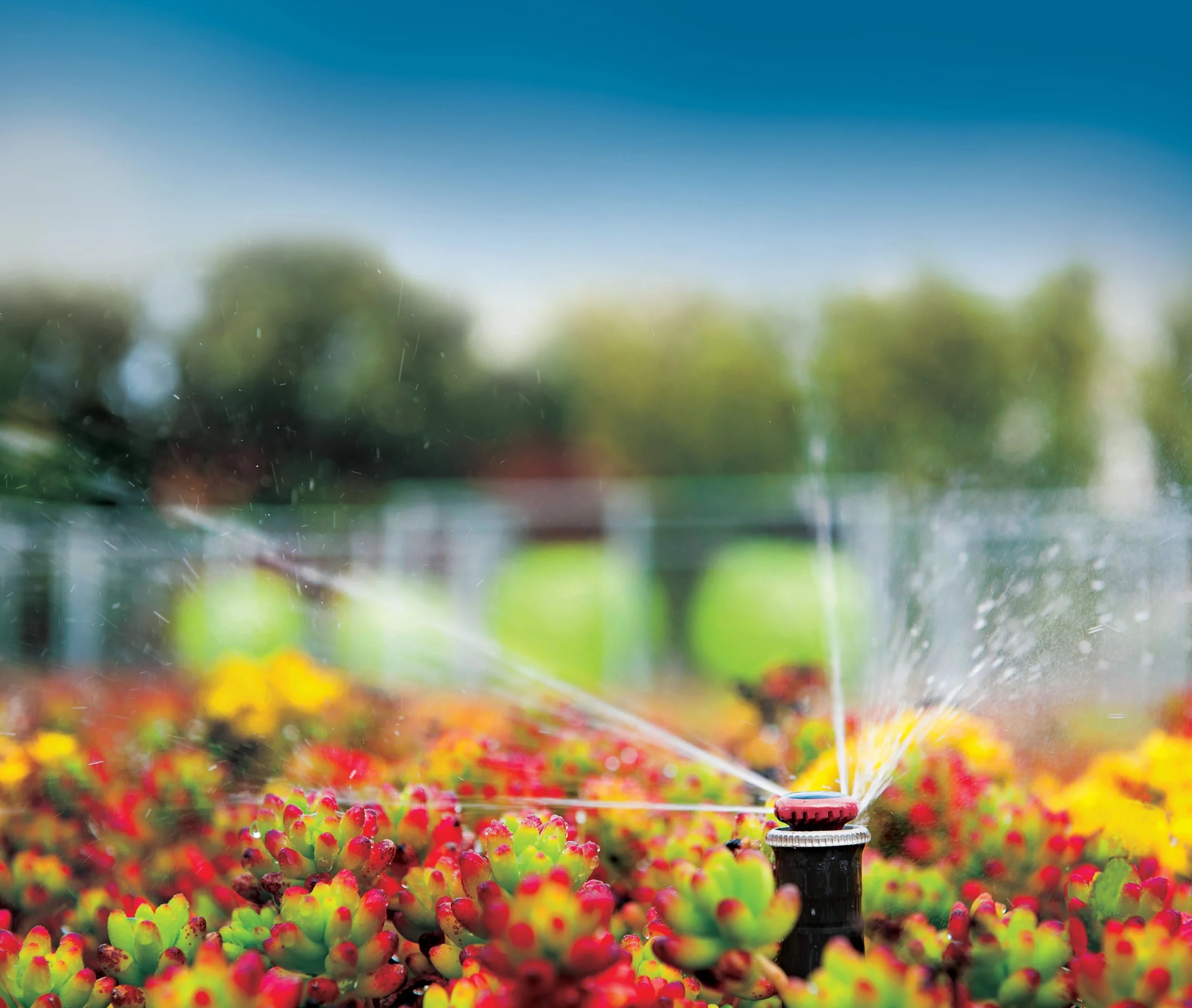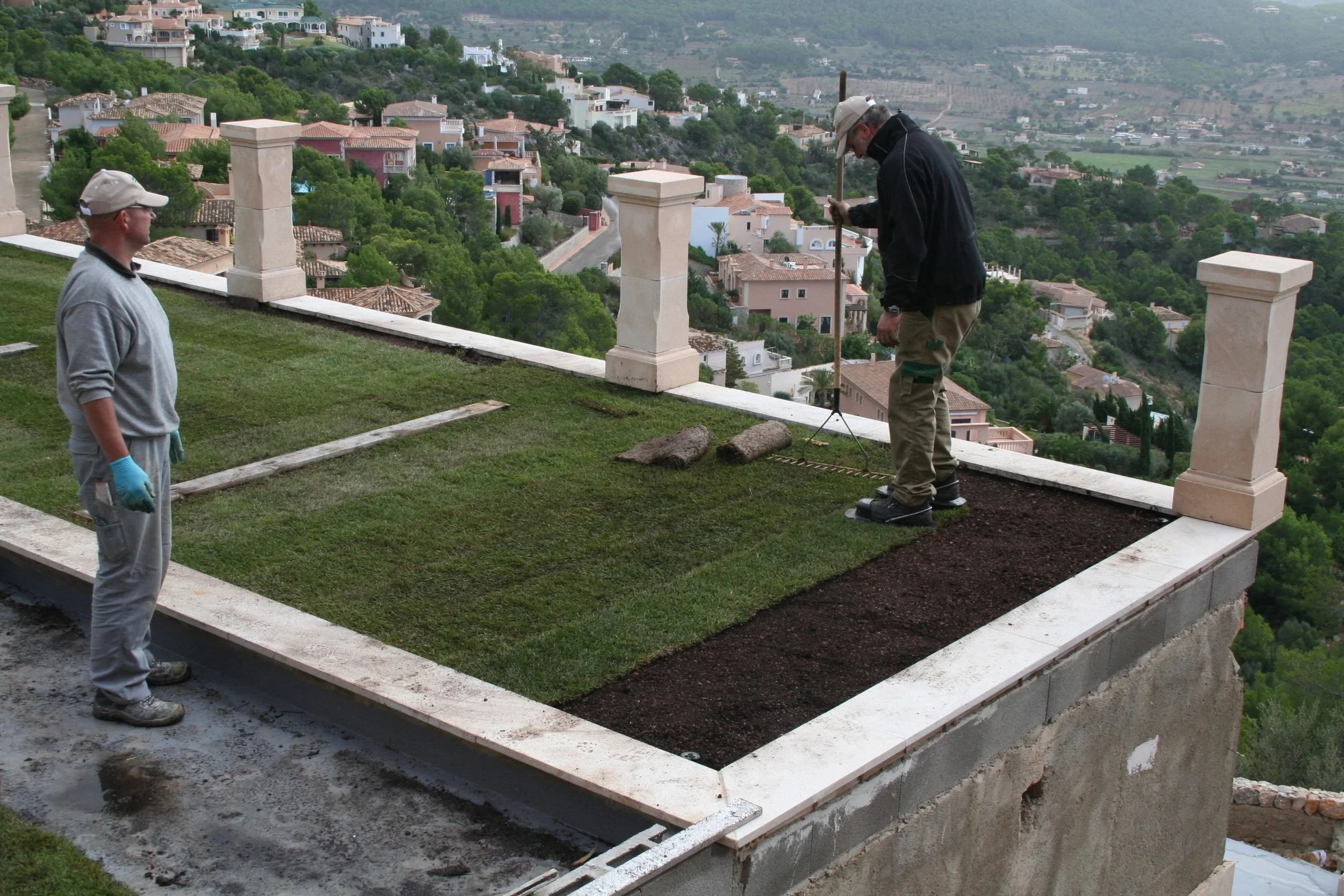Planning for a Successful Green Roof Irrigation System
Advertisement
Multi-stream, multi-trajectory nozzle on pop-up body irrigating succulent tray system. Photo: Hunter Industries
The ecosystem services provided by green roofs in the built environment deliver numerous benefits to our communities. Reduced heat island effects, cooler structure temperatures, wildlife habitat, appeasing aesthetics, and environment enhancements are just a few of the benefits we enjoy. Ensuring these benefits are maximized takes planning, coordination and skilled execution along with foresight to deliver a lengthy beneficial lifespan of the green roof. One of these components is a properly designed, managed, and maintained irrigation system. Let’s review key components of irrigation that will help sustain a successful green roof.
Water Source, Available Water Pressure, and Available Flow
Delivering water to a roof top may be challenging so identifying a water source early in the design phase is critical. Water may be delivered from a portable source in the building, a rainwater collection and storage on the roof, or a dedicated point of connection from municipal utility. Knowing available pressure and flow helps with selection of irrigation application devices. Each irrigation application device has an optimum pressure requirement. Drip and micro-irrigation optimum operating pressure ranges from 10 – 60psi. Conventional sprays nozzles operate at 30psi. Multi-stream multi-trajectory nozzles operate between 40 – 45psi. Rotors operate between 30 – 60psi. Remember that every 1 foot of elevation loss or gain results in the addition or subtraction of .433 psi from an irrigation system. Meaning, if an irrigation water source is at street level with 50 psi, and the green roof is 100 feet above the street, the water pressure would only be 6.7 psi once delivered to the rooftop. This does not include pressure loss produced by water movement through pipes and equipment. Booster pumps may be required to properly operate the irrigation system. In addition, consider filtration requirements for rainwater harvest systems to prevent clogging of irrigation equipment.
Roof top turf with overhead irrigation. Photo: Hunter Industries
Trades Collaboration
The utilities mapping and engineering for a building can be complex. Communicate early on with project architects and engineers to share your system requirements. Identify irrigation point of connect, supply line mapping, equipment locations, etc. Share systems requirements and equipment sizes with these trades to collaborate on necessary space for adequate installation and continued maintenance. Understand fire codes and proper wiring considerations when transiting between floors and throughout the structure. Also, calculate the weight of water filled irrigation systems and apply water to green roofs and share with engineers so they can structurally accommodate the project. Remember that a gallon of water weighs approximately 8.34 lbs and a cubic foot of water weighs 62.43 lbs.
Advertisement
Application Devices
Know the soil and plants specifications of a project before choosing irrigation application devices. Green roof soils are heavily engineered to reduce weight. This results in fast draining media that has minimal moisture holding capacity. Multi-stream multi-trajectory overhead application devices apply water slowing allowing even distribution and decreased run-off with these soils. Drip and micro-spray devices apply water very efficiently, but the water is typically delivered at a single point. This results in a small oversaturation area where applied water is rendered ineffective and is lost down the drain. Where drip is necessary, consider fleece wrapped application devices that spread water evenly through the soil while holding water available for plant use. Planting trays have become a popular planting solution and are best irrigated with overhead application. Understand mature plant sizes to decrease overhead spray pattern blockage, additional riser components may be required.
Site Conditions and Zoning
Specific site conditions often dictate irrigation system components and zoning. Wind drift is always of concern. It’s best to limit or eliminate the amount of water overspray onto adjacent green roof features such as windows, vehicles, walking tracks, or other site amenities. Rotors, multi-stream multi-trajectory nozzles, and flat profiles spray nozzles cut through breeze better than typical spray heads, reducing water loss while fleece wrapped drip products eliminate wind drift all together. Shade impacts throughout the day may require additional zoning conservation as well. Areas receiving more shade require less water than those receiving more sun. Separate these areas into different irrigated zones so they may be managed appropriately. Additionally, understand how different irrigation components react to weather and sun exposure. Irrigation components are typically installed underground and not subject to deterioration through atmospheric and ultraviolet factors. Ensure the use of UV resistant materials and products that can stand up to increased weather exposure.
Fleeced wrapped dripline micro irrigation installation with covered remote control valves. Photo: Hunter Industries.
Irrigation Control
Selecting a proper irrigation controller helps ensure successful management of a project. As green roof soils tend to drain quickly, select a controller that offers cycle and soak capabilities to apply bursts of water, limiting runoff while still applying the water needs of plants. Consider EPA Watersense certified controllers which adjust irrigation schedules automatically to match plant requirements. Consider remote monitoring and management controllers which allow irrigation managers to remotely manage controllers opposed to having to be in front of the physical controller.
Advertisement
Management Components
Multi-stream, multi-trajectory nozzle on pop-up body irrigating planted succulents in engineered soil. Photo: Hunter Industries.
Protecting the green roof and structure from damage caused by irrigation leaks is paramount. Flow sensors work with irrigation controllers to learn and monitor flow in different zones in a system. When an overflow or underflow event occurs, some controllers can alert irrigation managers. When a master valve is installed with the irrigation system, the controller may have the capability to cut off water to the entire system, further preventing damage. Ensure irrigation controllers have the capability to appropriately manage flow sensors and master valves installed on projects.
Maintenance
Fleeced wrapped dripline micro irrigation installation with covered remote control valves. Photo: Hunter Industries.
Just like any mechanical device, irrigation systems require maintenance. Place irrigation equipment where it can be accessed and maintained. Ensure adequate between components for maintenance and replacement requirements. Develop and share as-built drawing to communicate and easily find equipment location. This is especially important as equipment may be in different rooms or floors of a structure. Consider the addition of quick couplers for washdown, temporary supplemental irrigation, or additional cleaning purposes. Install blow out ports for winterization practices where applicable. Create and budget for increased maintenance frequency. Include regular overhead application device adjustments, irrigation schedule adjustments, and check for system deterioration caused by weather and ultraviolet exposure.
Not to be forgotten is the value of collaboration with product manufacturer partners. Manufacturers and their representatives have project success best interests in mind and collaborating with these partners adds an extra level of oversight and expertise to benefit the project. While the irrigation system may or may not be visible, its beneficial impacts on the green roof will be greatly noticed and appreciated. Identifying solutions for the above topics, while collaborating with industry partners, creates a roadmap for successful project planning, installation, management, and maintenance for years to come to ensure a healthy and long-lasting green roof.
Advertisement
Bryce Carnehl, Hunter Industries, has been in the landscape industry for over 20 years working in construction, landscape architecture, sales, corporate social responsibility, and marketing. Throughout these years he has dedicated himself to promoting the value of green spaces.
Every project begins with a plan, and better planning leads to project success. Bryce now works to create business opportunity for landscape stakeholders through design, planning, and specification efforts. He believes that together we can build business prosperity, increase the value of landscapes, and ensure healthy communities in which we all live, work, and play. Email Bryce here.









